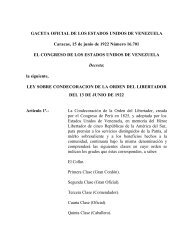1 Observing the normal Zeeman effect in transverse and longitudinal ...
1 Observing the normal Zeeman effect in transverse and longitudinal ...
1 Observing the normal Zeeman effect in transverse and longitudinal ...
You also want an ePaper? Increase the reach of your titles
YUMPU automatically turns print PDFs into web optimized ePapers that Google loves.
• Set <strong>the</strong> polarization filter to 0° <strong>and</strong> <strong>the</strong> (unshifted) component <strong>in</strong> <strong>the</strong> middle should<br />
disappear.<br />
b) <strong>Observ<strong>in</strong>g</strong> <strong>in</strong> longitud<strong>in</strong>al configuration:<br />
• Carefully rotate <strong>the</strong> entire setup of <strong>the</strong> cadmium lamp with <strong>the</strong> magnet by 90°.<br />
• First observe <strong>the</strong> circular fr<strong>in</strong>ge pattern without magnetic field (I = 0 A).<br />
• Slowly <strong>in</strong>crease <strong>the</strong> magnet current until <strong>the</strong> split fr<strong>in</strong>ges <strong>and</strong> are clearly separated.<br />
• Record what you observe.<br />
To dist<strong>in</strong>guish between σ + <strong>and</strong> σ - components:<br />
• Introduce a quarter-wavelength plate <strong>in</strong>to <strong>the</strong> ray path between <strong>the</strong> cadmium lamp <strong>and</strong> <strong>the</strong><br />
polarization filter <strong>and</strong> set it to 0°.<br />
• Set <strong>the</strong> polarization filter to +45° <strong>and</strong> –45°. In each case one of <strong>the</strong> two doublet components<br />
should disappear.<br />
Part 2. Quantitative measurements of <strong>the</strong> <strong>Zeeman</strong> <strong>effect</strong><br />
To perform quantitative measurements of <strong>the</strong> splitt<strong>in</strong>g of <strong>the</strong> red cadmium spectral l<strong>in</strong>e as a<br />
function of magnetic flux density <strong>the</strong> eyepiece, used for <strong>the</strong> first part of <strong>the</strong> experiment, is replaced<br />
with <strong>the</strong> l<strong>in</strong>ear CCD array <strong>and</strong> <strong>the</strong> <strong>in</strong>tensity of a l<strong>in</strong>e through <strong>the</strong> r<strong>in</strong>g system of <strong>the</strong> <strong>in</strong>terferometer is<br />
displayed on <strong>the</strong> PC. To perform quantitative measurements <strong>the</strong> lamp is place <strong>in</strong> <strong>the</strong> <strong>transverse</strong><br />
configuration. The basic configuration should look like <strong>the</strong> schematic diagram shown <strong>in</strong> figure 6.<br />
Make sure <strong>the</strong> <strong>in</strong>terference filter is as close as possible to <strong>the</strong> CCD array so as to stop room light<br />
hitt<strong>in</strong>g <strong>the</strong> array.<br />
Cd<br />
lamp<br />
Condenser<br />
lens<br />
Polariser<br />
Figure 6. Schematic diagram of optical setup for quantitative measurements<br />
Adjust<strong>in</strong>g <strong>the</strong> setup<br />
The software for <strong>the</strong> CCD camera can be used to adjust <strong>the</strong> camera sett<strong>in</strong>gs to optimise data<br />
collection. For <strong>the</strong> <strong>in</strong>itial sett<strong>in</strong>g up of <strong>the</strong> experiment set <strong>the</strong> camera to use only 256 pixels (button<br />
with a camera <strong>and</strong> I <strong>in</strong> <strong>the</strong> corner). This will allow <strong>the</strong> screen to be refreshed more quickly which<br />
aids <strong>in</strong> sett<strong>in</strong>g up <strong>the</strong> experiment. Once <strong>the</strong> setup is complete set <strong>the</strong> camera to 2048 pixels (button<br />
with a camera <strong>and</strong> II <strong>in</strong> <strong>the</strong> corner). It is also possible to adjust <strong>the</strong> exposure time (us<strong>in</strong>g <strong>the</strong> buttons<br />
with a magnify<strong>in</strong>g glass) so that <strong>the</strong> peaks have an <strong>in</strong>tensity of approximately 50 %.<br />
To ensure that <strong>the</strong> CCD is <strong>in</strong> <strong>the</strong> focal plane of <strong>the</strong> imag<strong>in</strong>g lens (f = 150 mm), move <strong>the</strong> imag<strong>in</strong>g<br />
lens along <strong>the</strong> optical axis until <strong>the</strong> peaks of <strong>the</strong> observed curve are sharply imaged <strong>and</strong> show <strong>the</strong><br />
maximum <strong>in</strong>tensity. The centre of <strong>the</strong> r<strong>in</strong>g system must <strong>the</strong>n be imaged on <strong>the</strong> CCD l<strong>in</strong>e. For this,<br />
you can ei<strong>the</strong>r move <strong>the</strong> VideoCom perpendicular to <strong>the</strong> optical axis or tilt <strong>the</strong> etalon <strong>in</strong>terferometer<br />
slightly us<strong>in</strong>g <strong>the</strong> adjust<strong>in</strong>g screws. The centre of <strong>the</strong> r<strong>in</strong>g system is on <strong>the</strong> CCD l<strong>in</strong>e when fur<strong>the</strong>r<br />
adjustment does not cause any more peaks to emerge <strong>and</strong> <strong>the</strong> two central peaks (left <strong>and</strong> right<br />
<strong>in</strong>tersections of <strong>the</strong> <strong>in</strong>nermost r<strong>in</strong>gs) are <strong>the</strong> maximum distance apart.<br />
Move <strong>the</strong> condenser lens until you obta<strong>in</strong> uniform illum<strong>in</strong>ation of <strong>the</strong> entire CCD l<strong>in</strong>e.<br />
6<br />
Etalon<br />
Imag<strong>in</strong>g lens<br />
f=150 mm f=150 mm<br />
Interference<br />
filter<br />
λ=643.8 nm

















